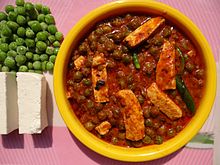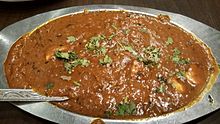User:MarJan96/sandbox
 Paneer | |
| Alternative names | Poneer, Fonir, Chhana, Chhena |
|---|---|
| Type | Cheese |
| Place of origin | Indian Subcontinent |
| Main ingredients | Strained curdled milk |
| Other information | Rich source of milk protein |
Paneer (wymawiany /pəniːr/) - krótkodojrzewający ser, popularny na subkontynencie indyjskim. Jest młodym, nietopliwym miękkim serem powstałym w wyniku połączenia krowiego mleka o wysokiej temperaturze wraz z sokiem z cytryny, octem, kwaskiem cytrynowym lub jogurtem. W efekcie dochodzi do separacji serwatki i skrzepu mlecznego.
Pochodzenie wyrazu i historia[edit]
The word paneer entered English from the Hindi and Urdu term panīr, which comes from Persian panir (پنیر), meaning "cheese" in general, and ultimately from Old Iranian.[1][2] Armenian panir (պանիր), Azerbaijani pəndir, Turkish peynir and Turkmen peýnir, all derived from Persian panir, also refer to cheese of any type.[3] The origin of paneer itself is debated. Vedic Indian, Afghan-Iranian and Portuguese-Bengali origins have been proposed for paneer.[4][5]
Vedic literature refers to a substance that is interpreted by some authors, such as Sanjeev Kapoor, as a form of paneer.[4] According to Arthur Berriedale Keith, a kind of cheese is "perhaps referred to" in Rigveda 6.48.18.[6] However, Otto Schrader believes that the Rigveda only mentions "a skin of sour milk, not cheese in the proper sense".[7] K. T. Achaya mentions that acidulation of milk was a taboo in the ancient Indo-Aryan culture, pointing out that the legends about Krishna make several references to milk, butter, ghee and dahi (yogurt), but do not mention sour milk cheese.[8]
Based on texts such as Charaka Samhita, BN Mathur wrote that the earliest evidence of a heat-acid coagulated milk product in India can be traced to 75-300 CE, in the Kushan-Satavahana era.[9] Sunil Kumar et al. interpret this product as the present-day paneer. According to them, paneer is indigenous to north-western part of South Asia, and was introduced in India by Afghan and Iranian travelers.[10] For the making of what is today called chhana, the Manasollasa recommends the addition of a sour substance (even sour curds from a previous operation) to boiled milk, after which the precipitate was separated, the cheese then mixed with rice flour and shaped into various balls, and then deep fried to make sweets. National Dairy Research Institute states that paneer was introduced into India by Afghan and Iranian invaders.[11]
According to another theory, the Portuguese may have introduced the technique of "breaking" milk with acid to Bengal in the 17th century. Thus, Indian acid-set cheeses such as paneer and chhena were first prepared in Bengal, under Portuguese influence.[8][12][13]
Wytwarzanie[edit]
| Nutritional value per 100 g | |
|---|---|
| Energy | 1,108.76 kJ (265.00 kcal) |
1.2 g | |
20.8 g | |
18.3 g | |
| Minerals | Quantity %DV† |
| Calcium | 16% 208 mg |
| †Percentages estimated using US recommendations for adults,[14] except for potassium, which is estimated based on expert recommendation from the National Academies.[15] Source: What is the nutritional value of paneer? - Doctor NDTV | |
Paneer jest wytwarzany poprzez dodanie kwasu spożywczego, takiego jak sok z cytryny, octu, kwasu cytrynowego lub dahi (jogurt), [16] do gorącego mleka w celu oddzielenia skrzepu od serwatki. Skrzep jest osuszany w muślinie lub cienkim płótnie, a nadmiar wody jest wyciskany. Powstały ser moczy się w schłodzonej wodzie przez 2-3 godziny, aby poprawić jego konsystencję i wygląd. Notabene, tę samą procedurę stosuje się do uzyskania włoskiego sera ricotta. Jedyną różnicą w wytwarzaniu ricotty jest dodanie śmietany kremówki podczas procesu zsiadania się mleka. Następne etapy wytwarzania sera różnią się w zależności od jego wykorzystania oraz regionalnych tradycji.
W kuchni północnoindyjskiej, zsiadłe mleko owija się w szmatkę, umieszcza się na dwie lub trzy godziny pod ciężarem (na przykład pod kamienną płytą), a następnie kroi się w kostkę w celu dodania do curry. Umieszczenie pod ciężarem na krótszy czas (około 20 minut) powoduje, że ser jest bardziej miękki i puszysty.
W kuchni bengalskiej i innych kuchniach wschodnioindyjskich istnieje odmiana o nazwie "chhena", która jest ręcznie ubijana lub ugniatana do konsystencji przypominającej ciasto, mocno osolona i utwardzona w celu wytworzenia paneer (zwanego ponir). Ta odmiana paneer jest zwykle spożywana podczas podwieczorku w towarzystwie herbatników lub różnego rodzaju pieczywa, smażona w lekkim cieście na głębokim oleju lub używana do gotowania.
W okolicach miasta Surat w Gudżaracie, Surti Paneer jest wytwarzany poprzez osuszanie skrzepu i dojrzewanie w serwatce od 12 do 36 godzin.
Use in dishes[edit]




Paneer is the most common type of cheese used in traditional cuisines from the Indian subcontinent. It is sometimes wrapped in dough and deep-fried or served with either spinach (palak paneer) or peas (mattar paneer).
The well-known rasgulla features plain chhana beaten by hand and shaped into balls which are boiled in syrup. The sana / chhana / chhena used in such cases is manufactured by a slightly different procedure from paneer; it is drained but not pressed, so that some moisture is retained, which makes for a soft, malleable consistency. It may, however, be pressed slightly into small cubes and curried to form a dalna in Maithili, Oriya and Bengali cuisines.
Paneer dishes[edit]
Some paneer recipes include
- Paneer pulao (paneer with rice)
- Mattar paneer (paneer with peas)
- Shahi paneer (paneer cooked in a rich Mughlai curry)
- Paneer tikka (a vegetarian version of chicken tikka, paneer placed on skewers and roasted)
- Paneer tikka masala
- Chili paneer (a Indo-Chinese preparation with spicy chilies, onions and green peppers, usually served dry and garnished with spring onions)
- Paneer pakora (paneer fritters)
- Palak paneer
- Ras malai
- Rasgulla
- Khoya paneer
- Paneer momo
Fast food[edit]

Most international fast food restaurants in India offer paneer-based food. McDonald's India serves the McSpicy Paneer[17] and Paneer Wrap.[18] Taco Bell India serves a paneer and potato burrito.[19] Little Caesars,[20] Pizza Hut,[21] Domino's,[22] and Papa John's[23] have pizzas with paneer toppings.
Similar cheeses[edit]
Anari, a fresh mild whey cheese produced in Cyprus, is very similar in taste and texture to fresh Indian paneer. Circassian cheese is produced using a similar method and is close in consistency to paneer, but is usually salted. Farmer cheese (pressed cottage cheese) and firm versions of quark are similar except that they are made from cultured milk and may be salted. Although many Indians translate "paneer" into "cottage cheese", cottage cheese may be made using rennet extracted from the stomach of ruminants and such varieties when pressed into farmer cheese are firmer than paneer. Queso blanco or queso fresco are often recommended as substitutes in the Americas and Spain as they are more commercially available in many American markets. Queso blanco can be a closer match, as it is acid-set while queso fresco frequently uses rennet at a lower temperature. Both are generally salted, unlike paneer. It is also similar to unsalted halloumi.
References[edit]
- ^ Company, Houghton Mifflin Harcourt Publishing. "The American Heritage Dictionary entry: paneer". www.ahdictionary.com. Retrieved 2019-09-30.
- ^ "Rastala or the Under-world". The Indian Historical Quarterly. 2 (1–2). Ramanand Vidya Bhawan: 236. 1985.
- ^ Davidson, Alan (2006). Jaine, Tom (ed.). The Oxford Companion to Food (2 ed.). Oxford: OUP Oxford. ISBN 978-0191018251.
panir and peynir, the Persian and Turkish words for 'cheese' (...)
- ^ a b Kapoor, Sanjeev (2010). Paneer. Popular Prakashan. p. 3. ISBN 9788179913307.
- ^ Roufs, Timothy G.; Smyth Roufs, Kathleen (2014). Sweet Treats around the World: An Encyclopedia of Food and Culture. ABC-CLIO. p. 168. ISBN 9781610692212.
- ^ Keith, Arthur Berriedale (1995). Vedic Index of Names and Subjects. Motilal Banarsidass. p. 209. ISBN 9788120813328.
- ^ Schrader, Otto (1890). Prehistoric Antiquities of the Aryan Peoples. C. Griffin. p. 319.
- ^ a b Walker, Harlan, ed. (2000). Milk - Beyond the Dairy: Proceedings of the Oxford Symposium on Food and Cookery 1999. Oxford Symposium. pp. 53–57. ISBN 9781903018064.
- ^ Rao, K.V.S.S. (1992). "Paneer technology — A review". Indian Journal of Dairy Science. 45. Indian Dairy Science Association: 281.
- ^ Kumar, Sunil; Rai, D.C.; Niranjan, K.; Bhat, Zuhaib (2011). "Paneer—An Indian soft cheese variant: a review". Journal of Food Science and Technology. 51 (5). Springer: 821–831. doi:10.1007/s13197-011-0567-x. PMC 4008736. PMID 24803688.
People during the Kusana and Saka Satavahana periods (AD75–300) used to consume a solid mass, whose description seems to the earliest reference to the present day paneer
- ^ Robinson, R. K.; Tamime, A. Y. (1996). Feta & Related Cheeses. CRC Press. p. 231. ISBN 9780747600770.
- ^ Chapman, Pat (2009). India: Food and Cooking: The Ultimate Book on Indian Cuisine. New Holland. p. 33. ISBN 9781845376192.
- ^ Wiley, Andrea S. (2014). Cultures of Milk. Harvard University Press. p. 2. ISBN 9780674369702.
- ^ United States Food and Drug Administration (2024). "Daily Value on the Nutrition and Supplement Facts Labels". Retrieved 2024-03-28.
- ^ National Academies of Sciences, Engineering, and Medicine; Health and Medicine Division; Food and Nutrition Board; Committee to Review the Dietary Reference Intakes for Sodium and Potassium (2019). Oria, Maria; Harrison, Meghan; Stallings, Virginia A. (eds.). Dietary Reference Intakes for Sodium and Potassium. The National Academies Collection: Reports funded by National Institutes of Health. Washington, DC: National Academies Press (US). ISBN 978-0-309-48834-1. PMID 30844154.
- ^ Adiraja Dasa. The Hare Krishna book of Vegetarian Cooking. Bhaktivedanta Book Trust, 1989, ISBN 0-902677-07-1
- ^ "McDonald's launches McSpicy products". The Hindu. April 3, 2011.
- ^ "Spice it up with McDonald's" (PDF). McDonald's India (Press release). Archived from the original (PDF) on October 29, 2013.
- ^ Investor Place (March 30, 2011). "Taco Bell paneer and potato burritos are a hit". MSN. Archived from the original on March 24, 2012. Retrieved July 1, 2011.
- ^ "Little Caesars India menu".
- ^ "Pizza Hut India menu".
- ^ "Dominos Peppy Paneer Pizza".
- ^ "Papa Johns Pizza India menu".
Category:Indian cuisine Category:Indian cheeses Category:Punjabi cuisine Category:Nepalese cuisine Category:Vegetarian cuisine Category:Bengali cuisine Category:Sri Lankan cuisine
